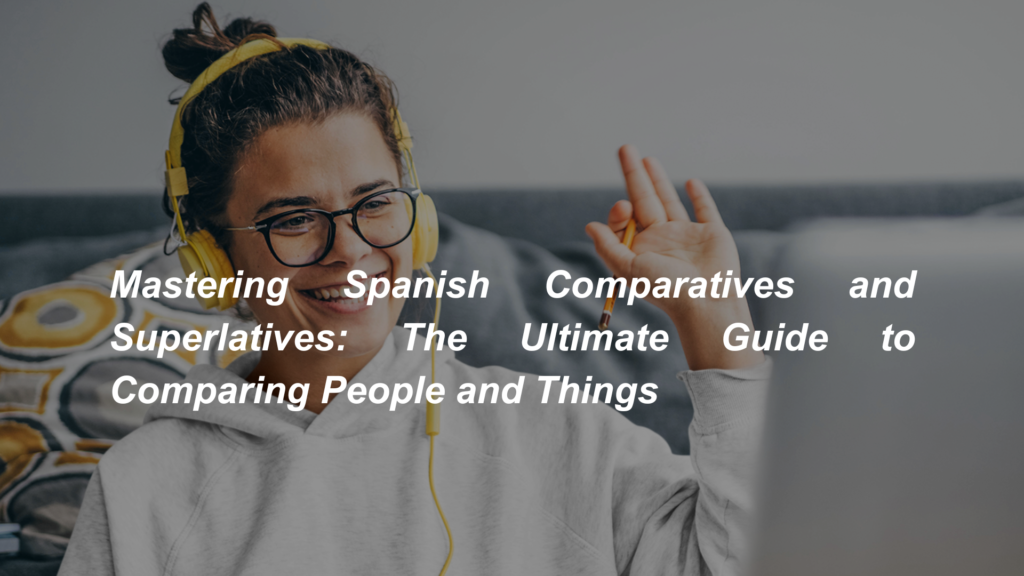Mastering Spanish Comparatives and Superlatives: The Ultimate Guide to Comparing People and Things
Mastering Spanish Comparatives and Superlatives: The Ultimate Guide to Comparing People and Things
Estimated reading time: 8 minutes
When learning a new language, one of the most important skills is describing how things or people compare to each other. In Spanish, comparatives and superlatives are used to compare qualities and attributes, making them essential for clear communication. Whether you’re comparing people, objects, or ideas, understanding this grammar pattern will enrich your ability to express opinions and describe things with precision.
In this guide, we’ll dive into the intricacies of comparatives and superlatives in Spanish, provide in-depth explanations of their forms and usage, and show you how they relate to their Hindi and English counterparts. We’ll also discuss exceptions and common irregularities in this pattern. By the end of this article, you’ll have a thorough understanding of how to use comparatives and superlatives confidently in Spanish.

Introduction to Comparatives and Superlatives in Spanish
Comparatives and superlatives are used to describe how two or more things compare in terms of quality, quantity, or degree. In English, comparatives often involve adding “-er” to adjectives (e.g., “smaller”) or using “more” (e.g., “more intelligent”). Superlatives, on the other hand, describe the highest or lowest degree and use the “-est” ending (e.g., “smallest”) or “most” (e.g., “most intelligent”).
In Spanish, the structure is a little different but equally logical. The Spanish language uses specific words like más (more) and menos (less) for comparisons and el/la más (the most) or el/la menos (the least) to form superlatives.
Understanding Comparatives in Spanish
A comparative is used when you compare two things to express which one has a greater or lesser degree of a particular quality.
Forming Comparatives in Spanish
To form a comparative, follow this structure:
Más + adjective + que (more + adjective + than)
Menos + adjective + que (less + adjective + than)
For example:
- María es más alta que Ana.
María is taller than Ana.
Hindi: मारिया अना से लंबी है। (Maria Ana se lambi hai.) - Este coche es menos caro que el otro.
This car is less expensive than the other one.
Hindi: यह कार दूसरी कार से कम महंगी है। (Yeh car doosri car se kam mehngi hai.)
Comparing Two Things: Examples
- El libro es más interesante que la película.
The book is more interesting than the movie.
Hindi: यह किताब फिल्म से अधिक दिलचस्प है। (Yeh kitaab film se adhik dilchasp hai.) - Mi casa es menos grande que tu casa.
My house is less big than your house.
Hindi: मेरा घर तुम्हारे घर से छोटा है। (Mera ghar tumhare ghar se chhota hai.)
Understanding Superlatives in Spanish
Superlatives are used to express the highest or lowest degree of a quality, much like in English when we say “the tallest” or “the smallest.”
Forming Superlatives in Spanish
The formula for superlatives is:
El/la/los/las + más/menos + adjective + de
(The + most/least + adjective + of/in)
For example:
- María es la más alta de la clase.
María is the tallest in the class.
Hindi: मारिया कक्षा में सबसे लंबी है। (Maria kaksha mein sabse lambi hai.) - Este es el coche menos caro del mercado.
This is the least expensive car on the market.
Hindi: यह बाज़ार की सबसे सस्ती कार है। (Yeh bazaar ki sabse sasti car hai.)
Note: Superlatives in Spanish follow a different structure from English, where “the most” or “the least” replaces English’s use of “est” endings (e.g., tallest, biggest).
Comparison with Hindi and English
1. Comparatives: Spanish vs. English vs. Hindi
In English, comparatives use “more” or the “-er” suffix. In Hindi, comparatives are often expressed with the word से (se), meaning “than.”
Example:
- Spanish: Mi coche es más rápido que tu coche.
- English: My car is faster than your car.
- Hindi: मेरी कार तुम्हारी कार से तेज़ है। (Meri car tumhari car se tez hai.)
Here, más (more) works like “faster” in English and तेज़ (tez) in Hindi, and que (than) is equivalent to से (se) in Hindi.
2. Superlatives: Spanish vs. English vs. Hindi
Superlatives in Spanish are formed with el/la más (the most), while English uses “the -est” or “the most.” In Hindi, superlatives often use words like सबसे (sabse) for “the most.”
Example:
- Spanish: Él es el más inteligente de la clase.
- English: He is the smartest in the class.
- Hindi: वह कक्षा में सबसे बुद्धिमान है। (Vah kaksha mein sabse buddhimaan hai.)
In this sentence, el más (the most) in Spanish parallels the most/smartest in English and सबसे (sabse) in Hindi.
-
Product on sale
 French DELF B1
French DELF B1₹32,600.00
₹36,300.00
Grammar Pattern Breakdown
1. Using “Más” and “Menos” for Comparatives
- Más + adjective + que = more than
Example: Este perro es más grande que el gato. (This dog is bigger than the cat.)
Hindi: यह कुत्ता बिल्ली से बड़ा है। (Yeh kutta billi se bada hai.) - Menos + adjective + que = less than
Example: El apartamento es menos caro que la casa. (The apartment is less expensive than the house.)
Hindi: यह अपार्टमेंट घर से कम महंगा है। (Yeh apartment ghar se kam mehnga hai.)
2. Using “El/La Más” and “El/La Menos” for Superlatives
- El/la más + adjective + de = the most
Example: Ella es la más inteligente de la clase. (She is the smartest in the class.)
Hindi: वह कक्षा में सबसे बुद्धिमान है। (Vah kaksha mein sabse buddhimaan hai.) - El/la menos + adjective + de = the least
Example: Este es el menos importante de los documentos. (This is the least important of the documents.)
Hindi: यह दस्तावेज़ों में से सबसे कम महत्वपूर्ण है। (Yeh dastavezon mein se sabse kam mahatvapurn hai.)
Exceptions and Irregular Forms
While many adjectives follow the regular más/menos + adjective structure, there are several irregular comparatives and superlatives in Spanish that change completely. These need to be memorized.
Common Irregular Comparatives:
- Bueno (good) → mejor (better)
Example: Este libro es mejor que ese. (This book is better than that one.)
Hindi: यह किताब उस से बेहतर है। (Yeh kitaab us se behtar hai.) - Malo (bad) → peor (worse)
Example: El clima es peor hoy. (The weather is worse today.)
Hindi: आज मौसम और खराब है। (Aaj mausam aur kharaab hai.)
Common Irregular Superlatives:
- Bueno (good) → el/la mejor (the best)
Example: Es el mejor restaurante de la ciudad. (It’s the best restaurant in the city.)
Hindi: यह शहर का सबसे अच्छा रेस्टोरेंट है। (Yeh sheher ka sabse achha restaurant hai.) - Malo (bad) → el/la peor (the worst)
Example: Este es el peor día de la semana. (This is the worst day of the week.)
Hindi: यह सप्ताह का सबसे खराब दिन है। (Yeh saptah ka sabse kharaab din hai.)
Example Sentences Using Comparatives and Superlatives
Here are six example sentences showcasing both comparatives and superlatives, along with English and Hindi translations:
- Spanish: Ella es más inteligente que su hermano.
English: She is more intelligent than her brother.
Hindi: वह अपने भाई से अधिक बुद्धिमान है। (Vah apne bhai se adhik buddhimaan hai.) - Spanish: Este es el edificio más alto de la ciudad.
English: This is the tallest building in the city.
Hindi: यह शहर का सबसे ऊँचा इमारत है। (Yeh sheher ka sabse ooncha imarat hai.) - Spanish: Mi coche es menos rápido que el tuyo.
English: My car is less fast than yours.
Hindi: मेरी कार तुम्हारी से कम तेज़ है। (Meri car tumhari se kam tez hai.) - Spanish: Ella es la peor cantante del grupo.
English: She is the worst singer in the group.
Hindi: वह समूह की सबसे खराब गायिका है। (Vah samooh ki sabse kharaab gayika hai.) - Spanish: Este café es mejor que el otro.
English: This coffee is better than the other one.
Hindi: यह कॉफी दूसरी से बेहतर है। (Yeh coffee doosri se behtar hai.) - Spanish: Es el más pequeño de todos.
English: He is the smallest of all.
Hindi: वह सबमें सबसे छोटा है। (Vah sabmein sabse chhota hai.)
Frequently Asked Questions (FAQs)
Conclusion
Mastering comparatives and superlatives in Spanish is a key step toward speaking fluently and accurately describing the world around you. Whether you’re comparing people, places, or things, this grammar pattern allows you to express a range of ideas and opinions. By understanding how these structures differ from English and Hindi, you’ll find it easier to use them in conversation. Practice regularly, and soon you’ll be able to compare with confidence!
Enhance Your Spanish Skills!
To improve your Spanish further, consider enrolling in our Spanish Course at Learn Languages Store for just Rs. 16,300. Our courses are designed to help you build a strong foundation in the Spanish language in a fun and engaging way.
Contact Us to Learn More!
For more information about our courses, feel free to reach out to us at:
Address:
330, 3rd Floor, Big Splash (Near Vashi Bus Depot),
Sector 17, Vashi,
Navi Mumbai, Maharashtra 400703
Phone: +91-9594113111
Email: services@learnlanguages.store
Don’t miss the opportunity to enhance your language skills! Sign up today and start your journey to fluency in Spanish!










